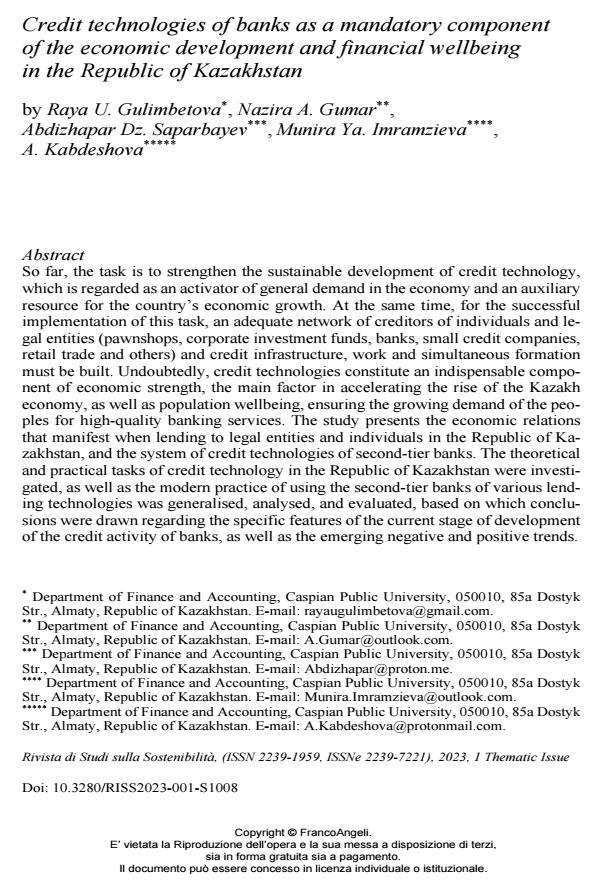Credit technologies of banks as a mandatory component of the economic development and financial wellbeing in the Republic of Kazakhstan
Journal title RIVISTA DI STUDI SULLA SOSTENIBILITA'
Author/s Raya U. Gulimbetova, Nazira A. Gumar, Abdizhapar Dz. Saparbayev, Munira Ya. Imramzieva, A. Kabdeshova
Publishing Year 2023 Issue 2023/1 T.
Language English Pages 15 P. 119-133 File size 137 KB
DOI 10.3280/RISS2023-001-S1008
DOI is like a bar code for intellectual property: to have more infomation
click here
Below, you can see the article first page
If you want to buy this article in PDF format, you can do it, following the instructions to buy download credits

FrancoAngeli is member of Publishers International Linking Association, Inc (PILA), a not-for-profit association which run the CrossRef service enabling links to and from online scholarly content.
So far, the task is to strengthen the sustainable development of credit technology, which is regarded as an activator of general demand in the economy and an auxiliary resource for the country’s economic growth. At the same time, for the successful implementation of this task, an adequate network of creditors of individuals and le- gal entities (pawnshops, corporate investment funds, banks, small credit companies, retail trade and others) and credit infrastructure, work and simultaneous formation must be built. Undoubtedly, credit technologies constitute an indispensable compo- nent of economic strength, the main factor in accelerating the rise of the Kazakh economy, as well as population wellbeing, ensuring the growing demand of the peo- ples for high-quality banking services. The study presents the economic relations that manifest when lending to legal entities and individuals in the Republic of Ka- zakhstan, and the system of credit technologies of second-tier banks. The theoretical and practical tasks of credit technology in the Republic of Kazakhstan were investi- gated, as well as the modern practice of using the second-tier banks of various lend- ing technologies was generalised, analysed, and evaluated, based on which conclu- sions were drawn regarding the specific features of the current stage of development of the credit activity of banks, as well as the emerging negative and positive trends.
Keywords: credit policy, stability, modernised banking technology, risks, financial crisis, Kazakh economics.
Raya U. Gulimbetova, Nazira A. Gumar, Abdizhapar Dz. Saparbayev, Munira Ya. Imramzieva, A. Kabdeshova, Credit technologies of banks as a mandatory component of the economic development and financial wellbeing in the Republic of Kazakhstan in "RIVISTA DI STUDI SULLA SOSTENIBILITA'" 1 T./2023, pp 119-133, DOI: 10.3280/RISS2023-001-S1008